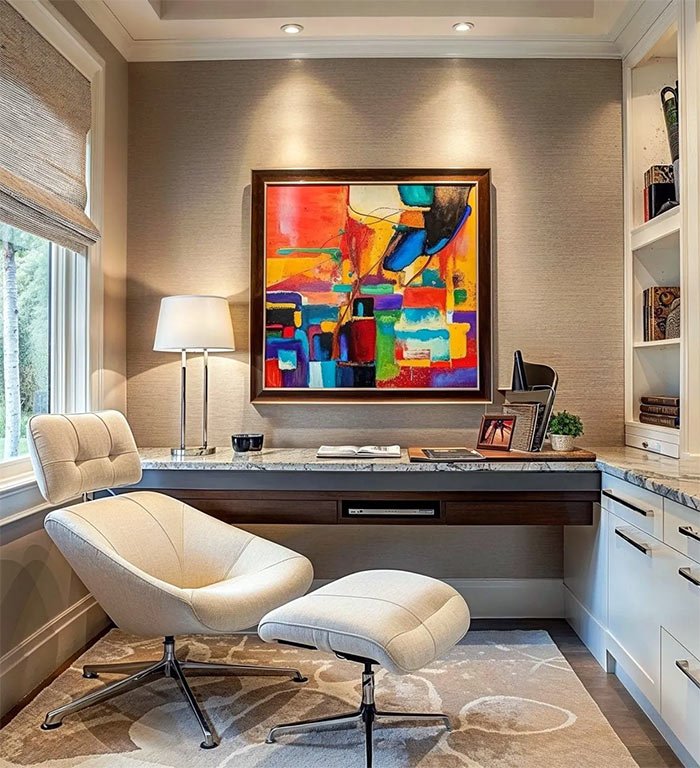In the era of remote work, your home office is more than just a functional space—it’s a reflection of your personal style and a backdrop for your professional life. A well-designed home office can boost creativity, enhance productivity, and make work-from-home life more enjoyable. Let’s explore how to transform your workspace through thoughtful design choices and inspiring color schemes.

@decorilla
Understanding Color Psychology in Workspaces
The colors you choose for your home office can significantly impact your mood, energy levels, and focus. Here’s a guide to help you select the perfect palette:
- Blue: Associated with calmness and productivity, blue is an excellent choice for maintaining focus. Consider a deep navy for a sophisticated look or a soft sky blue for a more serene atmosphere.
- Green: Symbolizing growth and balance, green can reduce eye strain and promote a sense of harmony. Sage green is trending for its earthy, calming properties.
- Yellow: The color of optimism and creativity, yellow can energize your space. Use it as an accent color to avoid overwhelming the senses.
- Gray: A neutral that exudes professionalism, gray serves as an excellent base color. Pair it with vibrant accents for a modern, balanced look.
- White: Creates a sense of spaciousness and cleanliness. It’s perfect for small offices or as a backdrop for colorful accessories.
Remember, you’re not limited to a single color. Creating a palette of complementary or analogous colors can add depth and interest to your office design.

@decorilla
Design Styles to Inspire Your Home Office Makeover
Your office design should reflect your personal taste while maintaining a professional atmosphere. Consider these popular styles:
- Minimalist: Clean lines, a neutral color palette, and clutter-free surfaces characterize this style. Opt for sleek, multifunctional furniture and hidden storage solutions.
- Scandinavian: Combining functionality with beauty, this style features light woods, white walls, and pops of color through artwork or accessories.
- Industrial: Embrace raw materials like exposed brick, metal fixtures, and reclaimed wood for an edgy, urban feel.
- Bohemian: For the free spirits, mix patterns, textures, and global-inspired elements. Balance it with organized storage to maintain professionalism.
- Modern Farmhouse: Blend rustic elements with modern simplicity. Think shiplap walls, barn doors, and modern lighting fixtures.

@decorilla
Creating a Cohesive Color Scheme
Once you’ve chosen your base style and primary colors, it’s time to create a cohesive scheme:
- The 60-30-10 Rule: Use your dominant color for 60% of the space (walls, large furniture), a secondary color for 30% (accent furniture, curtains), and an accent color for 10% (accessories, artwork).
- Monochromatic: Choose different shades and tints of the same color for a sophisticated, harmonious look.
- Complementary: Select colors opposite each other on the color wheel for a vibrant, energetic feel.
- Analogous: Use colors adjacent to each other on the color wheel for a serene, cohesive atmosphere.

@decorilla
Incorporating Texture and Pattern
To add depth to your color scheme and prevent a flat look:
- Use textured wallpaper or a grasscloth accent wall to add visual interest.
- Incorporate patterns through area rugs, curtains, or upholstered office chairs.
- Mix materials like wood, metal, glass, and fabrics to create a multi-dimensional space.

@decorilla
Lighting as a Design Element
Lighting isn’t just functional—it’s a crucial design component:
- Statement Fixtures: Choose a eye-catching desk lamp or pendant light that complements your style.
- Layered Lighting: Combine ambient, task, and accent lighting to create depth and functionality.
- Natural Light: Position your desk to take advantage of natural light, using sheer curtains to filter harsh sunlight.

@decorilla
Furniture Selection for Style and Function
Your furniture choices should marry form and function:
- Desk: The centerpiece of your office. Choose a style that fits your aesthetic—a sleek glass top for modern spaces, a rustic wood desk for farmhouse styles, or a vintage writing desk for eclectic rooms.
- Chair: Opt for an ergonomic chair that doesn’t sacrifice style. Many modern designs offer both comfort and aesthetic appeal.
- Storage: Select bookcases, filing cabinets, and shelving units that complement your overall design. Open shelving can double as a display for decorative items.

@decorilla
Accessorizing Your Space
The right accessories can tie your whole design together:
- Artwork: Choose pieces that inspire you and complement your color scheme.
- Plants: Add life to your space with plants that thrive in office environments.
- Rugs: Define your workspace and add warmth with an area rug that pulls your color scheme together.
- Decorative Objects: Personalize your space with meaningful objects, but keep it professional and uncluttered.

@decorilla
Design Solutions for Common Home Office Challenges
- Small Spaces: Use light colors and mirrors to create the illusion of space. Opt for wall-mounted desks and floating shelves to maximize floor space.
- Dual-Purpose Rooms: Use room dividers or strategically placed furniture to separate your office area. Ensure your office design complements the room’s other function.
- Limited Natural Light: Compensate with warm artificial lighting and light-reflecting surfaces. Consider a light therapy lamp to boost mood and energy.

@mayflower
Bringing It All Together: A Design-Focused Makeover Plan
- Start with a mood board: Collect images, color swatches, and material samples that inspire you.
- Choose your primary color and design style.
- Select furniture that fits your chosen style and color scheme.
- Plan your lighting, considering both function and aesthetic.
- Add texture and pattern through textiles and wall treatments.
- Accessorize thoughtfully, ensuring each item serves a purpose (functional or inspirational).
- Review your design, ensuring it meets both your aesthetic desires and practical needs.
Remember, your home office should be a space that motivates and inspires you. Don’t be afraid to inject your personality into the design while maintaining a professional atmosphere. With careful color selection and thoughtful design choices, you can create a home office that you’ll love working in day after day.
